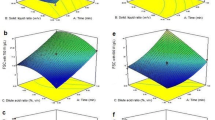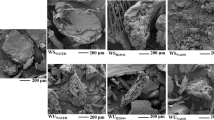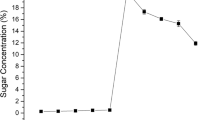Abstract
A novel process using chemical, thermal, and enzymatic treatment for conversion of hulled barley into fermentable sugars was developed. The purpose of this process is to convert both lignocellulosic polysaccharides and starch in hulled barley grains into fermentable sugars simultaneously without a need for grinding and hull separation. In this study, hulled barley grains were treated with 0.1 and 1.0 wt.-% sulfuric acid at various temperatures ranging from 110 to 170 °C in a 63-ml flow-through packed-bed stainless steel reactor. After sulfuric acid pretreatment, simultaneous conversion of lignocellulose and starch in the barley grains into fermentable sugars was performed using an enzyme cocktail, which included α-amylase, glucoamylase, cellulase, and β-glucosidase. Both starch and non-starch polysaccharides in the pre-treated barley grains were readily converted to fermentable sugars. The treated hulled barley grains, including their hull, were completely hydrolyzed to fermentable sugars with recovery of almost 100% of the available glucose and xylose. The pretreatment conditions of this chemical, thermal, and enzymatic (CTE) process for achieving maximum yield of fermentable sugars were 1.0 wt.% sulfuric acid and 110 °C. In addition to starch, the acid pretreatment also retained most of the available proteins in solid form, which is essential for subsequent production of fuel ethanol and high protein distiller’s dried grains with solubles co-product.



Similar content being viewed by others
Abbreviations
- Hulled barley:
-
Barley kernels which retain their hulls during harvesting and storage
- De-hulled barley:
-
Hulled barley kernels that had their hulls removed by a physical method such as abrasion or another de-hulling technology
- Hull-less barley:
-
A type of barley containing a genetic hull-less trait. The barley hulls are loosely attached and are lost during the harvesting process
References
The Library of Congress. Retrieved from http://thomas.loc.gov/cgi-bin/bdquery/z?d110:h.r.00006.
US Department of Agriculture National Agricultural Statistics Service (USDA-NASS) (2009). Crop acreage and yield US maps showing counties crop year 2008 United States. Retrieved May 2009 from http://www.nass.usda.gov/Charts_and_Maps/Crops_County/index.asp.
Chesapeake Bay Commission (2007). Biofuels and the Bay: getting it right to benefit farms, forests and the Chesapeake. Retrieved from http://www.chesbay.state.va.us/Publications/BiofuelsAndTheBay1.pdf.
Chesapeake Bay Commission (2008). Next-generation biofuels. Taking the policy lead from the nation. Retrieved from http://www.chesbay.state.va.us/Publications/nexgen%20biofuels1.pdf.
Gibreel, A., Sandercock, J. R., Lan, J., Goonewardene, L. A., Zijlstra, R. T., Curtis, J. M., et al. (2009). Applied and Environmental Microbiology, 75, 1363–1372.
Casebier, R. L., Hamilton, J. K., & Hegert, H. L. (1969). Tappi, 52(12), 2369–2377.
Fernandez-Bolanos, J., Felizon, B., Heredia, A., Guillen, R., & Jimenez, A. (1999). Bioresource Technology, 68, 121–132.
Lora, J. H., & Wayman, M. (1978). Tappi, 61, 47–50.
Burns, D. S., Ooshima, H., & Converse, A. O. (1989). Applied Biochemistry and Biotechnology, 20/21, 79–94.
Grohmann, K., Torget, R., & Himmel, M. (1985). Biotechnology and Bioengineering Symposium, 15, 59–80.
Kim, J. S., Lee, Y. Y., & Torget, R. W. (2001). Applied Biochemistry and Biotechnology, 91–93, 331–340.
Grethlein, H. E. (1985). Bio/Technology, 3, 155–160.
Allen, S. G., Schulman, D., Lichwa, J., Antal, M. J., Jennings, E., & Elander, R. (2001). Industrial and Engineering Chemistry Research, 40, 2352–2361.
Mok, W. S., Antal, M. J., Jr., & Varhegyi, G. (1992). Industrial & Engineering Chemistry Research, 31(1), 94–100.
Sun, Y., & Cheng, J. J. (2005). Bioresource Technology, 96(4), 1599–1606.
Nguyen, Q. A., Tucker, M. P., Keller, F. A., & Eddy, F. P. (2000). Applied Biochemistry and Biotechnology, 84–86, 561–576.
Saha, B., Iten, L. B., Cotta, M. A., & Wu, Y. V. (2005). Process Biochemistry, 40(12), 3693–3700.
Kulp, K., & Ponte, J. G., Jr. (Eds.) (2000). Handbook of cereal science and technology, 2nd edn. Boca Raton: CRC, p. 92.
Kim, T. H., Taylor, F., & Hicks, K. B. (2008). Bioresource Technology, 99, 5694–5702.
ICC Standard Method No. 168. Vienna: International Association for Cereal Science and Technology.
AOAC 990.03 (2000). Gaithersburg: Association of Official Agricultural Chemists.
AACC 46-30 (2003). St. Paul: American Association of Cereal Chemists.
AOAC 14.067 (2000). Gaithersburg: Association of Official Agricultural Chemists.
ICC Standard Method No. 166 (1998). International Association for Cereal Science and Technology 1998.
AOAC 995.16 (2000). Gaithersburg: Association of Official Agricultural Chemists.
AACC 32-33 (2003). St. Paul: American Association of Cereal Chemists 2003.
Moreau, R. A., Powell, M. J., & Singh, V. (2003). Journal of the American Oil Chemists’ Society, 80, 1063–1067.
AACC 08-01 (2003). St. Paul: American Association of Cereal Chemists; 2003.
LAP-002, 003, 017, 019—Determination of structural carbohydrates and lignin in biomass (2004). Golden: National Renewable Energy Laboratory. Retrieved from http://www.nrel.gov/biomass/analytical_procedures.html.
Xiang, Q., Lee, Y. Y., & Torget, R. W. (2004). Applied Biochemistry and Biotechnology, 113–116, 1127–1138.
Nghiem, N., Hicks, K., Johnston, D., Senske, G., Kurantz, M., Li, M., et al. (2010). Biotechnology for Biofuels, 3:8. Retrieved from http://www.biotechnologyforbiofuels.com/content/3/1/8.
Acknowledgment
This research was conducted as a part of a research project with ARS/USDA (CRIS no. 1935-41000-072-00D) and under a Cooperative Research and Development Agreement with ADM Research (Decatur, IL, USA) (CRADA no. 58-3K95-4-1050). We greatly acknowledge ADM for their research support.
Author information
Authors and Affiliations
Corresponding author
Additional information
Mention of trade names or commercial products in this article is solely for the purpose of providing specific information and does not imply recommendation or endorsement by the US Department of Agriculture.
Rights and permissions
About this article
Cite this article
Kim, T.H., Nghiem, N.P., Taylor, F. et al. Consolidated Conversion of Hulled Barley into Fermentable Sugars Using Chemical, Thermal, and Enzymatic (CTE) Treatment. Appl Biochem Biotechnol 164, 534–545 (2011). https://doi.org/10.1007/s12010-010-9155-1
Received:
Accepted:
Published:
Issue Date:
DOI: https://doi.org/10.1007/s12010-010-9155-1




